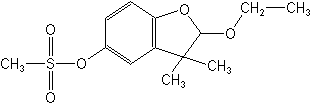Products
ETHOFUMESATE
Herbicide: benzofuran

NOMENCLATURE
Common name ethofumesate (BSI, E-ISO, (m) F-ISO, ANSI, WSSA)
IUPAC name (-2-ethoxy-2,3-dihydro-3,3-dimethylbenzofuran-5-yl methanesulfonate
Chemical Abstracts name (-2-ethoxy-2,3-dihydro-3,3-dimethyl-5-benzofuranyl
methanesulfonate
CAS RN [26225-79-6] EEC no. 247-525-3 Development codes
AE BO49913 (AgrEvo); NC 8438 (Fisons); SN 49913 (Schering); ZK 49913
PHYSICAL CHEMISTRY
Mol. wt. 286.3 M.f. C13H18O5S Form White, crystalline
solid; (tech. is a light brown crystalline solid; mild aromatic odour). M.p.
70-72 ºC; tech., 69-71 °C V.p. 0.12 to 0.65 mPa (25 °C) KOW
logP = 2.7 (pH 6.5-7.6, 25 °C) Henry 3.7 × 10-3 to
6.8 × 10-3 Pa m3 mol-1 S.g./density 1.29 (20 °C,
tech.) Solubility In water 50 mg/l (25 ºC). In acetone,
dichloromethane, dimethyl sulfoxide, ethyl acetate >600, toluene,
p-xylene 300-600, methanol 120-150, ethanol 60-75, isopropanol 25-30,
hexane 4.67 (all in g/l, 25 ºC). Stability Stable to hydrolysis
in water at pH 7 and 9. At pH 5.0, DT50 940 d, forming the hydroxy
analogue. Phototransformed in water, DT50 31 h. Degraded in air,
DT50 4.1 h.
Biochemistry Inhibits lipid synthesis (not ACCase inhibition). Mode of action Selective systemic herbicide, absorbed by the emerging shoots (grasses) and roots (broad-leaved plants), with translocation to the foliage. Not readily absorbed by leaves after the plant has generated a mature cuticle. Inhibits the growth of meristems, retards cellular division, and limits formation of waxy cuticle. Uses Used pre- and/or post-emergence in sugar and other beet crops, turf, ryegrass and the other pasture grasses, at 0.3-2.0 kg a.i./ha. It is effective in controlling a wide range of important grasses and broad-leaved weeds, with a good persistence of activity in the soil. In beet crops, 1.0-2.0 kg/ha can be used, but ethofumesate is normally recommended at 0.2-2.0 kg/ha in tank-mixtures or co-formulations with other residual or contact herbicides for use in beet. A high degree of tolerance is also shown by strawberries, sunflowers, Phaseolus beans and tobacco, depending on the time of application. Phytotoxicity Onions, peas, beans, carrots, and cotton are tolerant to some extent. Formulation types EC; SC.
